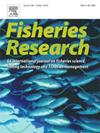大西洋鳕鱼、极地鳕鱼和北方虾原位中观实验的宽带声学分类
IF 2.2
2区 农林科学
Q2 FISHERIES
引用次数: 0
摘要
北方虾(Pandalus borealis)和大西洋鳕鱼(Gadus morhua)渔业很容易误捕极地鳕鱼(Boreogadus saida),这是一种重要的北极饲料鱼类。除了提高非致命性种群科学评估调查的准确性外,对这些重合物种的声音信号进行区分还可以提供关于副渔获物风险的信息。为了实现自动原位分类,我们对大西洋鳕鱼、极地鳕鱼和北方虾进行了一系列单物种中介体实验,测量了它们的宽带目标强度光谱。利用宽带自主收发器(WBAT)完成了中频实验,采集了90-170 kHz和185-255 kHz之间的单个目标强度谱TS(f)。为每个物种提取数百个TS(f),并用于训练机器学习分类算法(即分类器)。我们发现两个监督学习分类器,LightGBM和支持向量机,能够在单个200 kHz换能器在宽带模式下对目标光谱形状实现高分类性能(89%)。这对于有效载荷有限的自主平台的声学分类很有希望。我们探索了单传感器目标光谱形状变异性的利用,并提供了克服与成功缩放方法相关的挑战的建议,不仅在北极,而且在全球范围内进行原位海洋物种分类。本文章由计算机程序翻译,如有差异,请以英文原文为准。
Broadband acoustic classification of Atlantic cod, polar cod, and northern shrimp in in situ mesocosm experiments
The northern shrimp (Pandalus borealis) and the Atlantic cod (Gadus morhua) fisheries are prone to bycatch of polar cod (Boreogadus saida), a key Arctic forage fish species. Discrimination between the acoustic signals from these coinciding species could provide information on the risk of bycatch in addition to improving the accuracy of non-lethal scientific stock assessment surveys. As a step towards automatic in situ classification, we conducted a series of single-species mesocosm experiments for broadband target strength spectra measurements of Atlantic cod, polar cod and northern shrimp. Mesocosm experiments were completed with a Wideband Autonomous Transceiver (WBAT) and collected individual target strength spectra, TS(f), between 90–170 kHz and 185–255 kHz. Hundreds of TS(f) were extracted for each species and used to train machine-learning classification algorithms (i.e. classifiers). We found that two supervised learning classifiers, LightGBM and support vector machine, were able to achieve high classification performance (89%) on target spectra shape with a single 200 kHz transducer operating in broadband mode. This is promising for acoustic classification from autonomous platforms with limited payload. We explore the utilization of single transducer target spectra shape variability and provide recommendations to overcome challenges associated with scaling the method successfully for in situ marine species classification not only in the Arctic, but globally.
求助全文
通过发布文献求助,成功后即可免费获取论文全文。
去求助
来源期刊

Fisheries Research
农林科学-渔业
CiteScore
4.50
自引率
16.70%
发文量
294
审稿时长
15 weeks
期刊介绍:
This journal provides an international forum for the publication of papers in the areas of fisheries science, fishing technology, fisheries management and relevant socio-economics. The scope covers fisheries in salt, brackish and freshwater systems, and all aspects of associated ecology, environmental aspects of fisheries, and economics. Both theoretical and practical papers are acceptable, including laboratory and field experimental studies relevant to fisheries. Papers on the conservation of exploitable living resources are welcome. Review and Viewpoint articles are also published. As the specified areas inevitably impinge on and interrelate with each other, the approach of the journal is multidisciplinary, and authors are encouraged to emphasise the relevance of their own work to that of other disciplines. The journal is intended for fisheries scientists, biological oceanographers, gear technologists, economists, managers, administrators, policy makers and legislators.
 求助内容:
求助内容: 应助结果提醒方式:
应助结果提醒方式:


